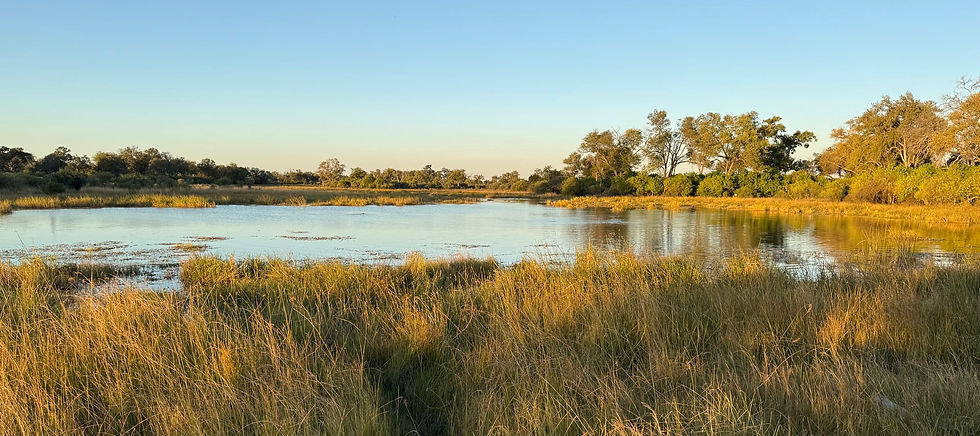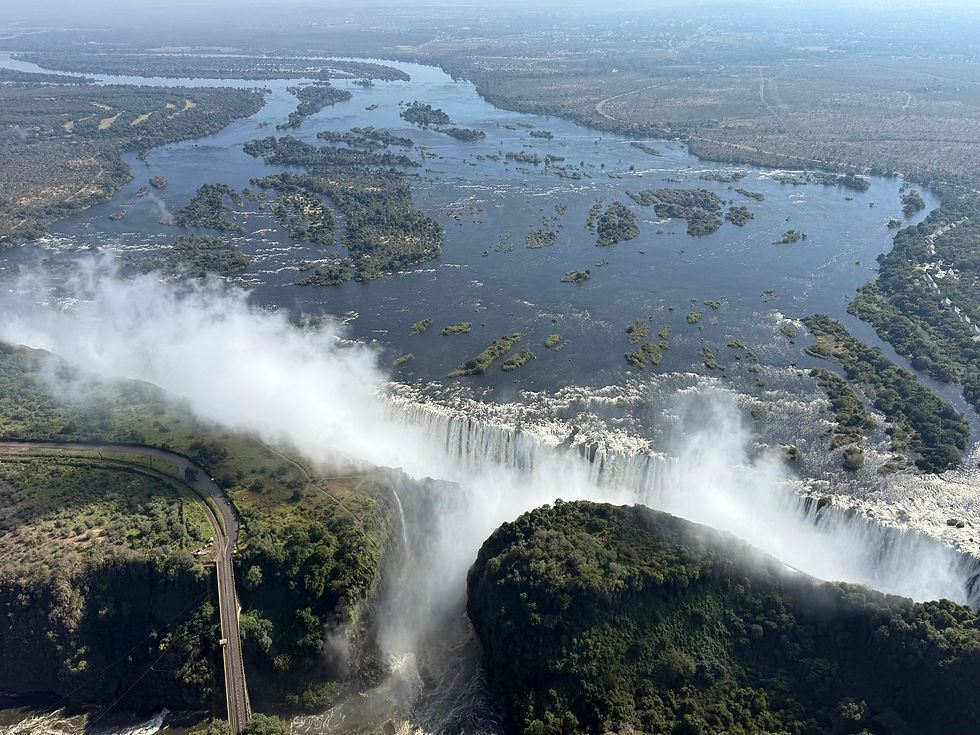10: The Okavango Delta
- nick4555
- Jun 21
- 8 min read
We're all really looking forward to this next leg of the journey; the Okavango Delta is famous for the beauty of its landscape and the wealth of wildlife that makes its home there.

On our way, we’re delighted by our stay for the next couple of nights - Mababe River Lodge & Campsite. This couldn't be more different from Savuti.


It's family run, has a lovely view from the bar and restaurant and the welcome is warm.

We opt for a guided game drive early this morning which takes us into the very outer reaches of Chobe National Park, hard up against the border with Moremi, as well as into the Mababe Depression.

We set off in the chill of pre-dawn as the sky is tinged pink by the rising sun. Early on we see a lone bull elephant grazing in a clearing, but we don't see much else.

We brace ourselves for a disappointing drive - but how wrong we are! For Janette especially, this turns into one of the best game drives we've had during our whole time in Africa.

Janette has been very keen to see Painted Dogs but given that they are now one of the rarest wild mammals in Africa with only around 6,000 adults left, she hasn't held out much hope. Our expert guide Sogs, takes us to a den, we are thrilled to bits - he didn't even know we wanted to see them!


At first we see about five adults, some standing and some lolling about in the long grass - and to be honest we're happy with that.

Sogs points out that the dogs have dried blood around their necks indicating that they've recently killed and fed; their stomachs are full and they're chilling out which is why we've been able to find them and why they are relaxed around us .

Not one of them makes any effort to avoid us.

We circle their den and see about five year-old pups snuggled up together, this is much better than we had dared to hope for!

Imagine then, our surprise and delight when a nursing mother arrives on the scene, goes down into the underground den and emerges with about fifteen tiny puppies.

The whole pack seems ecstatic to see the pups and pounces on them until the mother chases them away.


The pups start hungrily feeding, their little white-tipped tails waving in the air. None of the pack members seems remotely bothered by our presence and some come within a few feet of our vehicle.

This has been one of the best and most intimate game viewing experiences any of us has ever had and it's even better as we are the only people there - quite magical!


We continue our drive through some beautiful countryside, heading into the Mababe Depression for a chilly coffee stop.

This area is a 503 km² seasonal floodplain very near to our campsite.

It’s teaming with life; we see hippos in the water; a huge monitor lizard sunning itself on a termite mound; elephants; zebras; wildebeest; numerous antelopes and many species of birds.
If this is a taste of what the Okavango Delta has to offer, we're in!

We tweak our plans a bit at this point and on the recommendation of our guide Sogs we head to Hippo Pools Campsite in Khwai instead of the campsite we had intended to stay in - it proves to be a great choice.
Hippo Pools is situated just outside the village of Khwai which is a traditional rural village.


There’s very little here, we stop to buy a few supplies at the only one of the three shops that has any stock - or that is open!

This is wilderness camping par excellence! We arrive and book in; someone has to accompany us to our pitch as it is some distance away and we would never find it on our own.
Shaggy hops up onto Chris and Janet's running board but when they see a lion melting away into the bush he gets into the vehicle and snuggles up with Janet on the passenger seat - cosy!

We are told that under no circumstances must we walk to the ablutions block, we must drive as the chances of encountering a wild animal, lions included is high - yikes!


We are blown away by the beauty of the view from our pitch, it is right on the water and when we arrive there is a herd of elephants bathing nearby. The blue sky and the green plants at the water's edge frame the herd perfectly, it is an idyllic scene.


In addition to the elephants, we enjoy watching the many hippos in the water near us. A mother and her calf are on our pitch when we arrive and seem - justifiably - put out by having to move!

We hope that the hippos will come up out of the water to graze around our pitch during the night and Nick and Chris go to bed with cameras at the ready. Nick sleeps with the tent flap open and we nearly freeze to death!

To add insult to injury the hippos stay in the water and the marshy reeds providing only few photo opportunities.

We're up early the next day, not least to try to warm up! There's a real chill in the air now and it's clear that the season is changing; winter is coming to the southern hemisphere. We are collected by Shaggy and Eric who take us on a mokoro ride.

These traditional dugout canoes are no longer made of wood as they once were. In an effort to conserve trees and the wildlife that depends on them, the mokoros are now made of fibre glass which is painted brown in a nod to the wooden versions of old.

We glide along not far above the surface of the water and it's a very serene way to travel. We see various birds and some hippos but we're not sorry that the crocs fail to put in an appearance!

The mokoro feels a bit wobbly but our chauffeurs tell us to sit still and not panic, they have everything in hand - let's hope so!

We decide that one night at Hippo Pools is enough. We love it here but the fact that you can't walk about freely means we either stay all day and evening on our pitch or we have to pack everything up (the downside of a roof top tent) to drive somewhere and set it all back up again when we return.

We know we have a long drive ahead to the town of Maun so we decide to get going.
The drive is certainly long but the misery is added to by the condition of the road which is heavily corrugated and very dusty. We have been told that this drive will take about three hours but it's nearer five by the time we arrive.

Maun is a lively town (still officially known as a village though its the fifth largest town in Botswana); we had expected it to be very touristy but the overwhelming atmosphere is of a place where local people are getting on with their lives and although there is evidence of tourism it doesn't define the place; for this reason we prefer it to Victoria Falls, it feels more 'real'.

For us, until we have visited towns and villages in the countries we travel to and have seen how things work and how people go about their daily lives, we don't feel that we've really captured the essence of a country.
The wildlife we have seen in the three countries we've visited has been truly wonderful and we wouldn't have missed it for the world but the human factor is crucial to us and so we really enjoy Maun.

We have to get laundry done, a zip replaced on one of our bags and buy some spanners, all this involves going to small shops and stalls in out of the way corners of town and interacting with local people - which we love doing.

We do visit the tourist stalls which sell lots of the usual wooden carvings, block print textiles and bead work but what Janet and Janette are really interested in is the basket-work which this area is known for.


We have heard that some of the basket work is so tightly woven that the baskets can be used as beer kegs! The fibre used comes from the Mokolwane (the Real Fan Palm) and the different colours are achieved by soaking these fibres in natural plant dyes.

We have lunch at Hilary's, a lovely cafe owned and run by Hilary who came to Southern Africa from England many years ago and never went back. The tablecloths and cushions at Hilary's are made from beautiful African-print fabric, she tells us that we can get this in Maun and so another shopping project takes shape - Nick raises his eyes silently to the heavens!

The fabric is to be found in an unassuming, general hardware store; there is a great selection and it is inexpensive - Janette fills her boots!

Having driven around, seen and experienced the Delta at ground/river level, we decide that taking a flight from Maun over the Delta will be the best way to give us a ‘big picture’ overview of this impressive landscape.

The Okavango Delta is what is known as an endorheic delta meaning that it is one of only a very few, large, inland deltas with no outlet to the sea. Actually, it is the largest inland delta in the world.

The Okavango River begins life as the Cubango River 1,100 km away, in the Angolan Highlands, it flows as the Kavango River through Namibia and finally discharges its load into the desert sands of the Kalahari Basin forming a unique and important wetland ecosystem in the midst of the Kalahari Desert!

It is thought that once upon a time the river flowed all the way to the Indian Ocean but it now flows over three fault lines in the Kalahari Basin which serve to fan the river out and finally to dam it.

The rainy season swells the river in Angola and the water sets off on its journey to the Delta which takes several months. This means that high water in the Delta doesn't occur until the dry season, with peak levels usually reached in August. The water then gradually evaporates in the heat over the next few months.

The waters haven't yet reached Maun, they aren't expected until next month and so we are thwarted in our wish to take a boat ride out into the Delta.
We have however explored the Okavango Panhandle by boat and of course have taken a Mokoro ride so we don't feel too cheated though it would be amazing to see the flow of water actually arrive.

There is sufficient water present to give us the picture from the air. There are waterways all over the place and many pools and waterholes.

Our altitude is pretty low and we can see hippos and elephants below us. The vegetation isn't as green as we had imagined it would be but we think that things will green up as the waters rise. A flight is a perfect way to appreciate the huge extent of this wetland area.

The next leg of our journey will take us to an entirely different landscape - we're going to the Makgadikgadi Pans - the largest network of salt pans in the world - it’s the size of Switzerland!
Here’s a quick preview…

This is the most remote place we'll go to on this trip - let's hope the trip goes well!














Love Okavango. Glad you had a fab time!